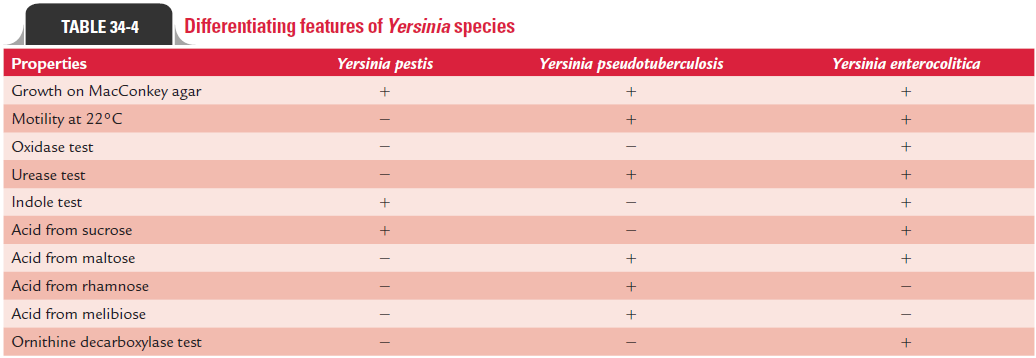Chapter: Microbiology and Immunology: Bacteriology: Yersinia
Yersinia pseudotuberculosis
Yersinia pseudotuberculosis
Y. pseudotuberculosis is the least common of the three main Yersinia species to cause human infections. The bacillus wasfirst described in 1889; first it was named as Pasteurella and then Shigella pseudotuberculosis. In 1960s, it was given the cur-rent name Y. pseudotuberculosis. Znamenskiy, a Russian worker, demonstrated the pathogenicity of the bacteria through self-inoculation.
Y. pseudotuberculosis is a small, ovoid, and bipolar stainedGram-negative bacillus. It is nonsporing, noncapsulated, and slightly acid fast. It is motile at 22°C but not at 37°C. The bacterium is oxidase negative, catalase positive, and urease positive. It is non–lactose-fermenting coccobacillus that is dif-ferentiated from other species, such as Y. enterocolitica, by its fermentation of sorbitol, ornithine decarboxylase activity, and other tests (Table 34-4).

Y. pseudotuberculosis is both aerobic and facultatively anaero-bic; and optimum growth occurs on MacConkey or eosin-meth-ylene blue (EMB) agar medium at 20–35°C. The growth of the bacteria is enhanced noticeably at lower temperatures (e.g., 4°C cold enrichment in buffered saline). The bacteria grow slowly on blood and chocolate agar plates, forming small colonies, gray and translucent colonies, at 24–72 hours of incubation.
Y. pseudotuberculosis has been classified into 6 serotypes (I–VI)and a number of subtypes, of which the O group, types I and II, are mainly responsible for human diseases. Approximately, 80% of human diseases are caused by type I serotypes. The bacteria show antigenic cross-reactivity with Y. pestis as well as salmonellae.
Y. pseudotuberculosis in experimentally infected guinea pigsproduces multiple nodules in the lungs, spleen, and liver, resem-bling tuberculous lesions, hence named pseudotuberculosis.
Humans acquire infections primarily through the ingestion of contaminated food products. An inoculum of 109 organisms is the infective dose. Y. pseudotuberculosis causes a variety of clini-cal diseases, such as mesenteric lymphadenitis, granulomatous disease, and dissemination with sepsis. Patients with advanced liver disease and evidence of cirrhosis are more likely to develop a septic disease.
Y. pseudotuberculosis primarily causes gastroenteritis. The incu-bation period varies from 5 to 10 days. Gastroenteritis is char-acterized by a self-limited mesenteric lymphadenitis simulating acute appendicitis. Fever, abdominal pain (often right lower quadrant location), and rash are a major triad of Y. pseudotubercu-losis infection. Diarrhea is not common. Erythema nodosum andreactive arthritis are the noted late complications of the infection.
· Izumi fever, a syndrome, is caused byY. pseudotuberculosis.The condition is characterized by scarlatiniform rash, sys-temic symptoms, and coronary artery aneurysms.
· The Far East scarlatinoid fever is another syndrome caused by the bacteria. Presence of a scarlatinoid-appearing rash on the head and neck, erythema on the upper and lower extrem-ity, mucous membrane enanthem, and strawberry tongue are characteristic features of the syndrome.
Erythema nodosum, arthralgias, reactive arthritis, and anky-losing spondylitis and terminal ileitis and intussusceptions, especially in children, are the other clinical manifestations of Y. pseudotuberculosis infection.
Y. pseudotuberculosis infection is distributed worldwide. Mostcases occur in winter months, because a cold temperature favors the growth and multiplication of the bacteria. Most cases have been reported in Europe. Nevertheless, large-scale outbreaks have also been documented in the Aomori region of Japan in the early 1990s, and in children consuming untreated drinking water in Okayama, Japan, in 1991. Cases of septicemia are less; less than 30 cases of septicemia have been reported in the world literature.
Y. pseudotuberculosis is primarily a zoonotic infection. Theanimal reservoirs include many mammalian and avian hosts, such as horses, cattle, dogs, deer, cats, rabbits, rodents, and birds (e.g., geese, turkey, ducks, canaries, cockatoos). Butchers working in abattoirs slaughtering swine are at an increased risk to Y. pseudotuberculosis infection.
The laboratory diagnosis of Y. pseudotuberculosis infection is made by the following methods:
· Isolation of the bacteria by culture from stool, blood, CSF, peritoneal fluid, synovial fluid, or other organ-based biopsy (e.g., intestinal tissue, skin).
Isolation of bacteria from stool is difficult, given the slow growth pattern and overgrowth of normal fecal flora. However, stool culture may be facilitated by cold enrich-ment, using special culture media, such as CIN agar, or by alkali treatment.
· Histological examination of specific tissue, such as mesen-teric lymph nodes, may show both pathologic and microbio-logic presence of organism.
· ELISA and agglutination tests are employed for demonstra-tion of serum antibodies, which may appear soon after the onset of illness but decrease over a period of 2–6 months. A rise in agglutinating antibodies in paired serum samples, collected after 2 weeks, is suggestive of the diagnosis. How-ever, the test shows false positive reactions in sera from patients infected with Yersinia, Vibrio,Salmonella, Brucella, and Rickettsia species due to the presence of cross-reactive antibodies.
Antibiotic therapy is indicated only for younger patients with critical illness, and in the immunocompromised patients. Tetracycline, aminopenicillins, and aminoglycosides are the antibiotics frequently used for treatment of the condition.
Related Topics